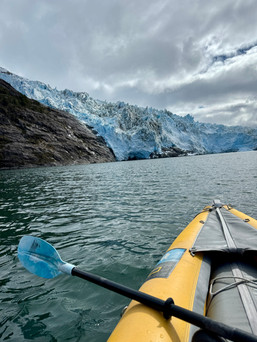Grosvenor Teacher Fellowship: Explore the World with the Professional Development Adventure of a Lifetime!
- Misha Smith
- Dec 24, 2023
- 4 min read
Updated: Feb 1, 2024
Misha Smith
Boise, Idaho
The Grosvenor Teacher Fellowship, offered through a partnership between National Geographic and Lindblad Expeditions, is an opportunity for teachers to embark on an expedition of geographic and scientific learning in locations around the world. 50 teachers from across North America are selected each year to take part in a two year ambassador fellowship that supports the National Geographic Society’s education initiatives and includes travel on one of Lindblad Expeditions’ state of the art expedition vessels to diverse ecosystems such as Antarctica, the Galapagos Islands, and Indonesia. Teachers in the cohort work together to develop learning materials inspired by their experiences for their classrooms and beyond. They become teacher mentors and share these materials and experiences with other educators and students through their connections with National Geographic Society’s education resources, which are free to educators worldwide.

The GTF 2023 cohort met in Washington DC at the National Geographic headquarters for pre-expedition training and collaboration.
The Grosvenor Teacher Fellowship was created by Lindblad Expeditions founder Sven-Olaf Lindblad in honor of Gilbert M. Grosvenor’s decades-long work with the National Geographic Society supporting teachers and promoting geographic learning. The 2023 cohort includes educators from 24 US states, 1 US territory and 5 Canadian provinces. These educators come from a variety of backgrounds that include not only traditional K-12 learning environments, but also preschools, art and music, STEM, after school and second language programs. Educators are selected through a competitive application process and their selection is a reflection of their passionate dedication to creating student explorers and stewards of our planet.

I learned of this fellowship through my friend and colleague, Susan Wolfe who traveled to the Galapagos Islands as part of the 2020 GTF cohort. I had already been using National Geographic’s many incredible education resources in my classroom and had taken several of the free professional development courses offered online that enriched my teaching. After a couple of applications, I was selected as part of the 2023 cohort to travel to Patagonia! I chose Patagonia because of the rich connections I could make with the 6th grade social studies and science curriculum.

Before I left for my expedition, I presented in each classroom of Hawthorne Elementary, where I am a 6th grade teacher. I taught them the National Geographic Explorer’s Mindset framework and each class created an inquiry question about Patagonia for me to investigate for them. These questions ranged from curiosity about the wildlife and ecosystems such as “How do plants, animals and insects work together in the ecosystem?”, to the geography of the area “How are glaciers formed and are they all melting?”, to the culture “What is it like to live in Patagonia?”. I even got my former 6th graders, now at South Junior High, involved as well by creating some student challenges for me to complete such as taste an iceberg, and stand under a glacial waterfall.
I spent two weeks on the Lindblad Expeditions ship, the National Geographic Explorer, with three other teachers from my cohort exploring the islands and fjords of Southern Patagonia. Every day we traveled to a new stunning location framed by the Andes Mountains to learn from naturalists, undersea specialists and National Geographic photographers. We observed unique glacial landscapes and wildlife through daily zodiac rides and hikes. A highlight for me was sea kayaking in an iceberg filled fjord next to a glacier, observing Andean Condors soaring in the cliffs overhead and listening to the sea ice crackle around our kayaks. Another experience I will never forget was observing a noisy colony of elephant seals with adorable seal pups sunning themselves in a river inlet. I was surprised to find so much plastic trash that had blown in from Asia to this uninhabited part of the world. We also learned about the invasive beaver problem that is destroying the beech forests of Southern Patagonia, as well as how climate change is causing the glaciers to melt at an alarming rate of 1.5 meters per year!
Exploring glacial landscapes and observing wildlife up close while learning with other teachers were highlights of my experience
We also had opportunities to learn about the cultures in Southern Patagonia. We embarked from the fishing port of Ushuaia, Argentina which is the southernmost city of the world and were able to explore the city after visiting Tierra del Fuego National Park. After we disembarked, we were given time to explore the tourist city of Puerto Natales, Chile and spent some time at a local horse ranch.
Once I returned to my school, I was able to go into each classroom and share photos and videos of my experiences with each class, as well as answer their inquiry questions. I also surprised my students from last year’s class by working with their counselor to pull them out of their advisory period at the end of the day and presenting to them at the junior high. My students were intrigued by the invasive beavers of Patagonia, and this inspired them when choosing their year long Geo Inquiry question: “How are invasive species affecting the native species in Idaho and how can we reduce these effects?” I am excited to see where this question takes them this year as they connect what they learned from me about Patagonia to Idaho.

Standing at the “Lighthouse at the End of the World” on Staten Island, Argentina with the National Geographic Explorer ship in the background.
Overall, the expedition was truly the professional development experience of a lifetime. Waking up each morning with a view of glaciers and beech forests outside my porthole, watching the sunset over the Andes Mountains every night was a surreal experience. I look forward to my continued work with the 2023 GTF cohort and National Geographic as well as sharing what I learned with other teachers across the state. This experience has not only given me real world geography and science connections to share with my students for years to come, but also the opportunity to work with incredible teachers from all over North America. I highly recommend more teachers in Idaho apply for this incredible learning opportunity. Applications are due January 7th, 2024 so there is still time for you to get your application in!


















Comments